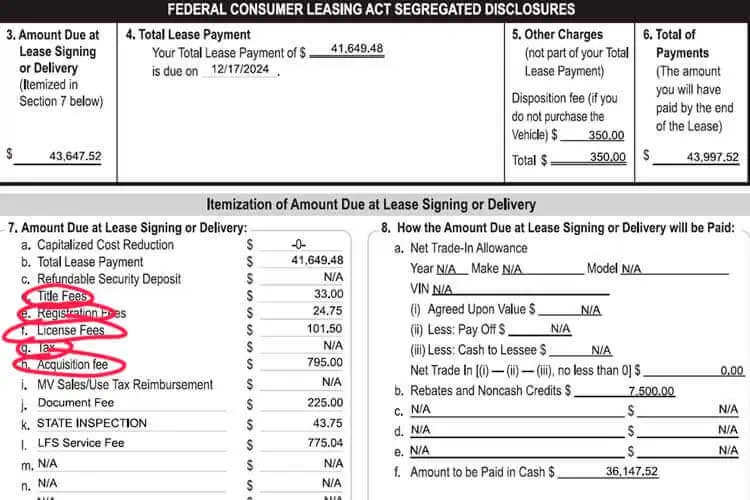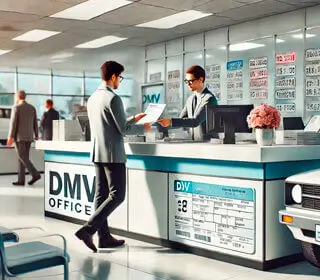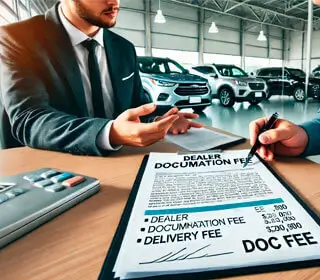Apr 01, 2025
Whats Fees and Taxes Will You Have to Pay the Car Dealer?
Feb 04, 2025
When you buy a car, most dealerships in the U.S. add extra charges on top of the sticker price. Many buyers are prepared for common costs like sales tax, registration fees, and license plates. However, there are other taxes and fees that often catch people off guard when signing a lease agreement.
With a leased vehicle, you pay for its depreciation plus interest. Just like with a purchase, leasing comes with additional fees, commissions, taxes, and other costs. The exact amount and type of fees will depend on the leasing company, dealership, state, and even the city where you live.

Many fees, whether for leasing or purchasing, are similar but may have different names. This means that the upfront costs of leasing and buying can be quite comparable. However, some fees are specific to leasing only. In this article, we’ll break down all the taxes and charges you may encounter. Analyze them to see if leasing or buying is better for you.
Table of Contents:
- Sales tax
- Registration fees
- Documentation fees
- Property tax
- Destination charge
- Insurance costs
- Bank fee
- Down payment (capitalized cost reduction)
- First monthly payment
- Wear and tear fees
- Excess mileage charges
- Disposition fee
- Security deposit
Fees can be grouped into two categories. Government-mandated fees, those non-negotiable. These fees are paid to the state or local government. Dealer fees – These depend on the leasing company’s policies, your credit score, negotiation skills, and other factors.
Sales Tax
Sales tax is a percentage of the car’s price, which varies by the state where the vehicle is registered. Some states, such as Alaska, Montana, Delaware, Oregon, and New Hampshire, do not charge sales tax, but you may still be required to pay a local use tax depending on your city or county.
When you lease a car, the financial institution handling the lease shifts the responsibility for sales tax onto you, even though they technically own the vehicle.
If you make an upfront payment (capitalized cost reduction) when leasing, the sales tax — whether local or state — will only apply to the portion of the car’s value covered in your monthly payments, rather than the total price. However, a key downside is that sales tax applies not just to the car’s depreciation, but also to finance charges in many states.
Here’s an example: If the local tax rate is 5%, you calculate the total tax amount by multiplying your monthly lease payment by 5%, then adding that amount to your payment.
Since tax laws frequently change, the best way to get the most accurate information about auto leasing taxes is to check with your local DMV (Department of Motor Vehicles) or your state’s Department of Revenue. Some states offer tax calculators or charts to help you estimate costs — check your local DMV website to see if this service is available.
Additionally, if you trade in a vehicle when leasing a new one, most states offer a sales tax credit based on the trade-in value.
Location-Based Taxes
In most states, sales tax is applied to your monthly lease payments, and if you make a down payment, tax is also charged on that amount. While buying a car often qualifies for a sales tax credit when trading in a vehicle, lease agreements don’t always offer the same benefit — and the tax calculation methods vary by state.
However, some states have unique tax policies when it comes to leasing. The differences are outlined in the table below.
| State | Tax Details | How Taxes are Paid |
|---|---|---|
| New York | Tax structure including city and state rates | Entire sales tax on the amount of lease payments must be paid in advance |
| Minnesota | — | |
| Ohio | All unofficial fees are taxed | |
| Montana | No sales tax | — |
| Arizona | Use tax is paid | |
| New Hampshire | Registration fees are paid | |
| Delaware | Fixed fee (Document Fee) | |
| Oklahoma | Excise tax | |
| Texas | Calculated based on the total sales price | Sales tax is paid on the full sales price |
| Illinois | Tax on monthly payments | |
| California | ||
| Georgia | One-time Title Ad Valorem Tax (TAVT) | Sales tax on the capitalized cost of the lease must be paid in advance |
| New Jersey | — | You can choose to pay the advance tax on the full purchase price or all lease payments |
| Virginia | No sales tax credit for trade-in vehicles; may need to pay property tax twice a year (through leasing company) | Full sales tax must be paid in advance |
To prevent tax evasion, sales tax must be paid based on where you live and garage the vehicle, not where you signed the lease or picked up the car from the dealership (with some exceptions for certain states and business registrations).
This means that if you move to another state or region during your lease, your taxes and monthly payments may change to reflect the tax rate of your new location.
Registration and Vehicle Title (Tag, License, Title Fees)

When leasing a vehicle, you are required to pay various fees to the Department of Motor Vehicles (DMV) for registration, license plates, and legal ownership (title). As mentioned earlier, these fees vary by state. You can check with your local DMV office for exact costs, but the most common fees include:
- Vehicle registration and title fees
- License plate and tag issuance fees
- Registration sticker fees
The registration and title fees are generally based on the value and weight of the vehicle. While the leasing company technically owns the car (as indicated on the title), the lessee is responsible for paying these fees under the lease agreement.
Dealerships collect these fees without markup and transfer them to state agencies. The total cost typically starts at $100 or more, covering the vehicle registration, license plates, and title issuance.
Before taking your new leased vehicle home, you must register it with the local DMV, which will also charge a small fee for license plates and tags. These fees are mandatory, whether you’re leasing or buying a car.
If you’re leasing an electric vehicle (EV) or a plug-in hybrid (PHEV), some states impose additional special registration fees ranging from $50 to $225 to offset lost gas tax revenue
Dealer Documentation Fee (Doc Fee)
 The dealer documentation fee (often called the “doc fee”) is an administrative charge applied to both leased and purchased vehicles. It may also appear under different names, such as “preparation fees” or “delivery fees.” In some cases, the doc fee is included in the vehicle’s purchase price, while in others, it is added separately.
The dealer documentation fee (often called the “doc fee”) is an administrative charge applied to both leased and purchased vehicles. It may also appear under different names, such as “preparation fees” or “delivery fees.” In some cases, the doc fee is included in the vehicle’s purchase price, while in others, it is added separately.
Dealerships charge this fee for processing paperwork and finalizing the transaction. While it is a legitimate administrative fee, the amount varies widely between dealerships, typically ranging from $200 to $800.
Since a portion of the doc fee contributes to dealer profit, it’s sometimes possible to negotiate a lower amount. However, in many cases, especially with lease agreements, the fee is non-negotiable because it is a fixed charge in the financing system.
To make the fee appear official, dealerships often pre-print it on the sales contract. Some dealers may be willing to reduce or waive certain delivery-related charges*, while others strictly follow their corporate policies and refuse to negotiate.
Some states cap documentation fees to prevent excessive charges. For example:
- California: The doc fee is limited to $85
- Florida: No legal limit, so the fee can be significantly higher
*The delivery fee (or destination charge) covers the cost of transporting the vehicle from the manufacturer to the dealership. This fee is typically passed on to the customer and varies based on the car’s make, model, and manufacturer’s policy.
Property Tax on Leased Vehicles
In certain states, such as Georgia, Virginia, and North Carolina, leasing a vehicle is subject to an annual property tax in addition to the sales tax. This tax is often referred to as an “ad valorem tax”, meaning it is based on the vehicle’s assessed value.
From a legal standpoint, the leasing company (as the vehicle's registered owner) is responsible for paying the tax. However, in practice, this cost is passed on to the lessee — just like other official fees and taxes.
Regardless of whether the bill is sent to the leasing company or directly to you, the financial burden ultimately falls on the lessee. Therefore, if you lease a vehicle in a state that imposes an annual property tax on cars, be prepared for an additional yearly expense beyond your regular lease payments.
Insurance Requirements for a Leased Vehicle
Auto insurance is not an official fee, but it is a mandatory requirement when leasing a vehicle. Without proper insurance, you may not be allowed to drive the car off the dealer’s lot. Some dealerships require proof of insurance at the time of signing, while others allow you to arrange coverage within a few days. Either way, securing insurance is one of the initial financial obligations when leasing a car.

Since the leasing company retains ownership of the vehicle, they require comprehensive insurance coverage — similar to what’s needed when financing a car. Insurance rates can vary based on several factors, including:
- Driver’s age and driving history
- Marital status
- Credit score
- Assets owned
- Current insurance status
- Location
- Vehicle’s value
Let's Take a Look at the Popular 3 Types of Insurance Coverage for a Leased Vehicle.
1. Liability Insurance (Mandatory Coverage)
All drivers must carry at least the minimum liability insurance required by their state. This coverage protects other drivers, pedestrians, and property owners in the event of an accident where you are at fault. However, it does not cover your own medical expenses or vehicle repairs.
2. Comprehensive & Collision Insurance
This coverage protects your vehicle from accidents, natural disasters, theft, and other damages — regardless of who is at fault. Since leased cars remain the property of the leasing company, they require full coverage insurance to safeguard their investment.
3. GAP Insurance (Guaranteed Asset Protection)
GAP insurance covers the difference between the remaining lease balance and the insurance payout if your car is totaled or stolen.
Since vehicles depreciate quickly, standard insurance may not cover the full amount you owe on your lease. GAP insurance protects both you and the leasing company by covering this shortfall. Many dealerships require GAP coverage, but purchasing it through a third-party insurer is often cheaper than adding it to your lease contract.
Dealer Fees in a Car Lease
In addition to standard taxes and government fees, leasing a car comes with additional dealership-related costs. These fees vary by dealership and leasing company, but they are often unavoidable. Below are the key dealer fees you may encounter:
- Acquisition Fee (Bank Fee)
- Security Deposit
- Down Payment (Capitalized Cost Reduction)
- First Monthly Payment
- Excess Wear and Tear Fee
- Excess Mileage Fee
- Disposition Fee
While some fees (such as the security deposit, excess mileage fee, and disposition fee) may be negotiable, others are typically non-negotiable and must be paid as part of the lease agreement
Acquisition Fee (Bank Fee)
The Acquisition Fee, also known as the Bank Fee, Lease Initiation Fee, or Finance Fee, is charged by the leasing company for setting up the lease agreement. This one-time administrative cost is similar to an origination fee on a mortgage loan.
Unlike auto loans, where this fee does not apply, an acquisition fee is standard in leasing. The leasing company determines the amount, but dealerships may mark it up for additional profit, making it a potential point of negotiation.
How Much Is the Acquisition Fee?
The fee typically ranges from a few hundred to over a thousand dollars, depending on the leasing company and vehicle type. On luxury vehicles, this fee is usually higher.
How Is the Fee Paid?
You can pay the acquisition fee in two ways:
- Upfront at signing – avoiding extra interest charges.
- Rolled into monthly payments – but this increases your overall cost because interest applies to the added amount.
Sometimes, the acquisition fee is not explicitly listed in the lease agreement but is included in the capitalized cost. More often, it's part of the due-at-signing amount when finalizing the lease. On average, this fee ranges from $500 to $800, though luxury brands may charge more.
Security Deposit
A Security Deposit, also known as a Guarantee Deposit, is an optional upfront payment made at the beginning of a lease. Its primary purpose is to reduce the leasing company's risk in case of missed payments or excessive wear and tear.
How Does a Security Deposit Work?
The deposit is fully refundable at the end of the lease, as long as there are no outstanding charges for:
- Excessive wear and tear
- Excess mileage
- Disposition (turn-in) fees
How Much Is the Deposit?
While not a fee in the traditional sense, the security deposit adds to your initial leasing costs. The amount is typically equal to one month’s lease payment and is paid at lease signing.
Does a Security Deposit Save You Money?
Yes, it can. While it does not reduce the lease balance subject to interest, it can lower your money factor (interest rate) and improve lease terms. This is because the deposit reduces the leasing company's risk.
Who Needs to Pay a Security Deposit?
- If you have a strong credit history or prior leases with the same financial institution, the deposit may not be required.
- If your credit score is lower, offering a higher deposit may help you secure better lease terms.
Can You Negotiate the Deposit?
In some cases, you can negotiate a lower money factor by offering a higher security deposit. The more you put down, the lower your interest rate (also known as the "money factor"). This can be a great deal if you have extra cash available, as the deposit is typically refunded at lease-end or can be applied toward final charges.
Capitalized Cost Reduction (Down Payment in Leasing)
A Capitalized Cost Reduction (Cap Cost Reduction) is an upfront payment that lowers the total cost of the lease. By making a down payment, you reduce the amount on which interest is charged, leading to lower monthly lease payments.
 How Does Cap Cost Reduction Work?
How Does Cap Cost Reduction Work?
- The amount you pay is deducted from the initial vehicle price (capitalized cost).
- The remaining amount, known as the adjusted capitalized cost, is what the leasing company uses to calculate your monthly payments.
- The larger your down payment, the lower your monthly lease payment.
Is a Down Payment Required?
Unlike financing a car, a down payment in leasing is optional. You decide how much to put down — or whether to put anything down at all. How it will affect your monthly payments, you can compare using our down payment calculator.
The Trade-Off: Lower Payments vs. Upfront Costs
✔ Pros:
✅ Lower monthly payments
✅ Less interest paid over the lease term
❌ Cons:
🚫 Requires more cash upfront
🚫 If the car is stolen or totaled early in the lease, you might lose your down payment (unless GAP insurance covers it)
Because leasing already requires other upfront costs (security deposit, first month’s payment, fees), some people choose a zero down lease to keep more cash on hand.
First Monthly Payment in Leasing
In addition to any down payment, your first monthly lease payment is due at the time of signing. Unlike a deposit or a fee, this is simply the first of your scheduled lease payments.
Key Differences Between Leasing & Financing Payments
- Leasing: Payments are due at the beginning of each month (paying for the upcoming month).
- Financing: Loan payments are due at the end of each month (paying for the previous month).
How Much is the First Payment?
- It depends on the vehicle price, lease terms, and financing rate.
- Typically, it starts at $200 or more, but luxury vehicles or long-term leases may have higher amounts.
What If There’s No First Payment?
Some lease offers waive the first payment as a promotional incentive. This can happen in two ways:
- A true waiver – The leasing company covers the first payment as part of a special deal.
- Payment rolled into the lease – The first month’s payment is included in the lease structure, meaning slightly higher monthly payments over the term.
Some manufacturers or dealers may also subsidize the first month as part of a zero-down lease promotion, which means no upfront payment at signing (except for required fees).
Excess Wear and Tear Fees in Leasing
During a lease, normal wear and tear is expected, but excessive damage can result in additional charges at the end of the lease term. These fees help the leasing company restore the vehicle to a resalable condition.
What Counts as Excess Wear and Tear?
A common way to determine if damage is acceptable is the "credit card test":
- If the damage fits under a standard credit card, it’s usually considered normal wear.
- If the damage exceeds this size, you may face charges.
However, each leasing company sets its own standards:
- Toyota allows scratches up to 3 inches.
- Other brands allowable scratch size - 2 inches, like Honda and BMW, provide official wear and tear guides outlining acceptable damage.
Inspection Process
- 1-2 months before your lease ends, an inspector assesses the vehicle for excessive damage.
- You will receive a damage report listing any excessive wear and tear.
- You can choose to fix the issues yourself (at a body shop or through your insurance) before returning the car.
Poor-quality repairs may still be considered excessive damage, so use a trusted repair shop!
Keep in mind, that a lease agreement requires routine maintenance such as oil changes, filter replacements, and other scheduled services must be performed during the lease term.
- Some leases include maintenance costs, but in many cases, you must pay for service separately.
- Always keep records of all maintenance work, as dealers require documentation to confirm the vehicle was properly serviced.
Returning Your Leased Vehicle
If you don’t plan to purchase the leased vehicle, consider detailing it before returning it: a wash, interior cleaning, and wax can make a positive impression and improve your chances of getting a better lease deal next time.
Modifications and Excess Wear Fees
Excess wear fees don’t just apply to visible damage — they also apply to any modifications you made to the vehicle.
- Custom wheels, aftermarket audio systems, or other additions may result in charges.
- Even if you think an upgrade adds value, the dealer expects the car to be returned in its original condition.
To avoid extra charges, restore the car to its factory setup before returning it.
Excess Mileage Fee
Every lease agreement sets a strict mileage limit—typically 10,000, 12,000, or 15,000 miles per year.
- If you exceed the agreed mileage, you’ll be charged a fee at the end of the lease.
- Fees typically range from $0.20 to $0.50 per mile, but for luxury brands, they can go up to $0.75 per mile.
How to Avoid Excess Mileage Charges
- Accurately estimate your annual mileage before signing the lease.
- If you commute long distances, leasing may not be the best option.
- Negotiate a higher mileage limit upfront if you anticipate driving more.
- Higher mileage leases cost more per month but help avoid large end-of-lease fees.
- Consider switching to another lease with the same dealership.
- If you exceed the mileage limit by 1,000–2,000 miles, some dealers waive the fee if you lease another vehicle from them.
- This depends on the manufacturer and loyalty program terms.
Disposal Fee
The disposal fee is charged by the leasing company at the end of the lease term to cover costs for vehicle preparation for resale or disposal. This fee can range from $200 to $450.
You can avoid paying the disposal fee if you buy out the leased vehicle or negotiate a new deal to lease a new car from the same dealer or brand. Alternatively, this fee can sometimes be offset by the deposit paid at the beginning of the lease.
Potential Additional Costs
If you decide to buy out the vehicle at the end of the lease, you will need to pay the residual value (ranging from 45% to 60% of the vehicle’s full value as stated in the contract). If you choose to terminate the lease early for financial or other reasons, an early termination fee will also apply.






